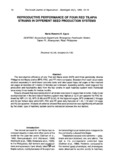Reproductive performance of four red tilapia strains in different seed production systems
- Global styles
- MLA
- Vancouver
- Elsevier - Harvard
- APA
- Help
Share
Abstract
The reproductive efficiency of one Thai red tilapia strain (NIFI) and three genetically diverse Philippine red tilapia strains (BFS, FAC, and PF) were compared. Breeders from each strain were stocked separately in land-based concrete tanks and lake-based hapa net cages or fine-meshed net cages at densities of 4 males:12 females per enclosure. Spawning activity, seed (egg and fry) production and hatchability data from the four strains in each hatchery system were monitored once every three weeks for twelve months.
Results showed that seed production in all strains was lower in cages than in tanks. Daily mean seed production in the land-based hatchery system was highest at 12.41 per spawner for FAC followed by NIFI (11.18), BFS (9.49) and PF (5.56). In the hapa net cages, BFS produced 2.19 eggs and fry per female daily while NIFI, FAC and PF gave daily harvests of 1.40, 1.18 and 1.14 eggs and fry per spawner. Analysis of variance showed that seed production was significantly influenced by the strain, type of hatchery system and the interaction between the two factors.
Suggested Citation
Eguia, M. R. R. (1996). Reproductive performance of four red tilapia strains in different seed production systems. The Israeli Journal of Aquaculture-Bamidgeh , 48(1), 10-18. http://hdl.handle.net/10862/1556
Type
ArticleISSN
0792-156XCollections
- Journal Articles [1258]



